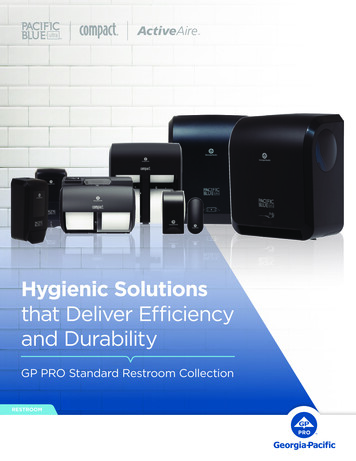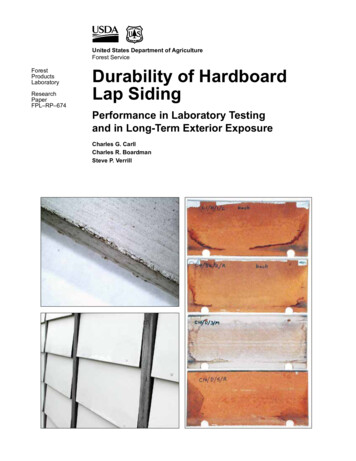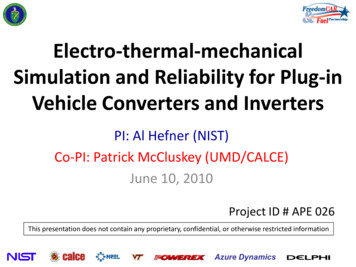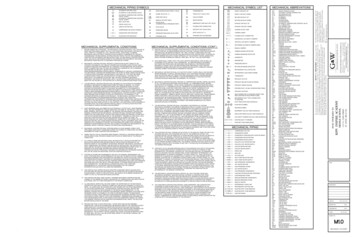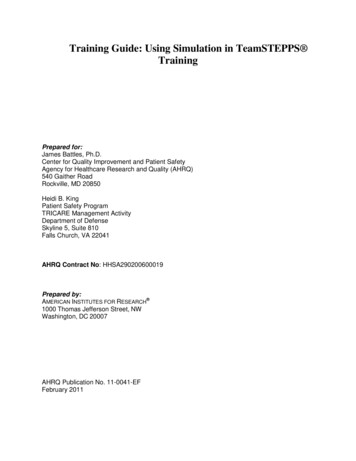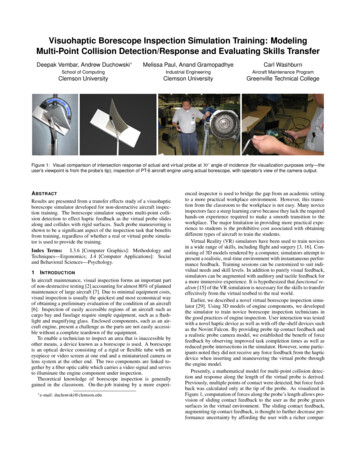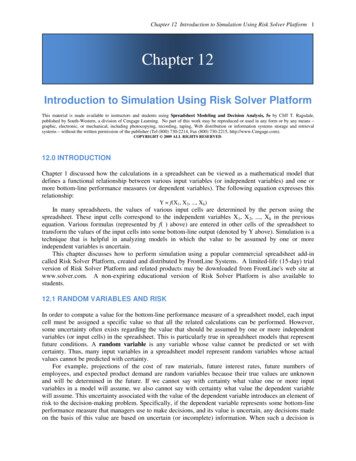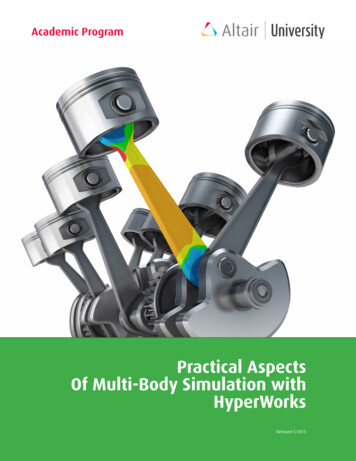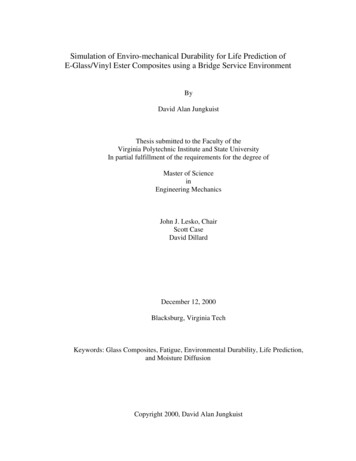
Transcription
Simulation of Enviro-mechanical Durability for Life Prediction ofE-Glass/Vinyl Ester Composites using a Bridge Service EnvironmentByDavid Alan JungkuistThesis submitted to the Faculty of theVirginia Polytechnic Institute and State UniversityIn partial fulfillment of the requirements for the degree ofMaster of ScienceinEngineering MechanicsJohn J. Lesko, ChairScott CaseDavid DillardDecember 12, 2000Blacksburg, Virginia TechKeywords: Glass Composites, Fatigue, Environmental Durability, Life Prediction,and Moisture DiffusionCopyright 2000, David Alan Jungkuist
Simulation of Environ-mechanical Durability for Life Prediction onE-Glass/Vinyl Ester Composites using a Bridge Service EnvironmentDavid Alan JungkuistJohn J. Lesko, ChairEngineering Science & Mechanics(ABSTRACT)In order for composites to become an accepted material for infrastructureapplication, life prediction and durability must be understood. The majority of studieshave examined the strength and fatigue response of composites under hot and/or moistconditions. Various researchers have also studied life prediction methods for compositematerials under fatigue, primarily for high performance applications. Little work hasbeen done to study durability under combined service conditions for composites used incivil infrastructure applications.This thesis focuses on the development of a life prediction model for use withfiber reinforced polymer composites in bridge service environments. The Tom’s CreekBridge of Blacksburg, VA is used as a guiding case study. First, the tensile properties ofthe composite were studied as a function of temperature and moisture. Damageaccumulation was studied as a function of cyclic loading and temperature cycles. Theenviro-mechanical conditions, including moisture, temperature and fatigue loading, werethen used in a computer simulation to predict the life of a vinyl ester/glass compositeunder an approximate bridge service environment.Finally, a laboratory simulation was conducted that approximates the temperatureand humidity that is seen at the Tom’s Creek Bridge, but in an accelerated time frame. Amulti-stress fatigue pattern, mimicking cars and trucks passing over the bridge, was used.One year of conditions was accelerated to approximately six hours and thirty-threeminutes using a servo-hydraulic test frame and environmental chamber.The final results showed that life prediction methodology conservativelypredicted the lifetime of a vinyl ester/glass composite under the enviro-mechanicalconditions. The damage of the composite was predominately driven by cyclic loading.The environmental conditions of moisture and temperature had only a small affect on thelifetime of the composite. This lack of environmental sensitivity is largely due to thedurability of the resin system.
DEDICATION“A teacher came to class with an empty glass mason jar and began filling it withlarge rocks. When the rocks reached the top of the jar he asked the class if the jar wasfull. A student answered yes. The teacher then added gravel to the jar and asked thesame question, “Is the jar full?” Another student, wising up to the situation said, “No.”Smiling from the correct answer, the teacher added sand to the jar, and upon finishingasked the question, “Is this jar now full?” The class responded with another no. Theteacher then brought out a pitcher of water and filled the jar. He then asked if the jarwas full. Not knowing what else could be placed in the jar, the class could only answerwith silence. The teacher interrupted the silence by saying that the jar was indeed full.Then the teacher asked his class what the moral of the demonstration was. An eagerstudent quickly responded that the demonstration shows that you can always find moreroom for responsibilities. Shaking his head no, the teacher explained that in life youhave many different size responsibilities and that you must first put in the big rocks, orthey will never fit in the jar.”This work is dedicated to the big rocks of my life. Thanks to my wife, Robbie,son Dominic, my parents, Larry and Teri, my brothers, Steve and John, and my familyin-law, John, Dianne and Jason Laurence. Your love and patience has been the key to myacademic success.iii
ACKNOWLEDGMENTSI wish to acknowledge the following individuals whose support and contributionsled to the success of this work.The Committee Dr. John “Jack” Lesko – thank you for your immense contributions to both myacademic and research success. Not only have you served as my advisor, but arole model and friend as well. Dr. Scott Case – thank you for your tremendous assistance in getting mycomputer simulation off of the ground. I appreciate your willingness to help. Ihope that you continue to find your joys in life, and never lose that outsidejumper. Dr. David Dillard – thank you for bringing me to Virginia Tech as a part of theSummer Undergraduate Research Program. The people and this area have made adramatic impact on my life that I will always remember and hold.The Materials Response Group Steve Phifer – thank you for all of your help. My thesis title should have you asa second author. I also appreciate your willingness to lend an ear. Your advicehas turned frustrating days into sunshine. And lastly, thank you for the baby criband stroller in support of my new family addition. Dr. Nikhil Verghese – thank you for your friendship and inspiration. I stillremember the SURP days and our big volleyball win during the CASS picnic. Dr. Byung-Kim Ahn – thank you for all of your smiles and support as I preparedfor fatherhood. I hope that you enjoy your stay in the state of Washington.iv
John Haramis – thank you for your help with freezing and thawing everything. Tozer Bandorawalla – thank you for all of the laughter. Your voice will ringthrough Patton Hall for years. I hope that our paths will cross again in the future. Dr. Howard Halverson – thank you for all of your materials testing help. I couldnot have broken so many things without your help. Sneha Patel – thank you for your patience and sharing of the environmentalchamber. Also, thank you for letting Lester stay with us. Mac McCord – thank you for pulling me out of my various testing jams. Boththe MRG and myself are forever in your debt. Beverly Williams and Shelia Collins – two of the best secretaries in the world.The MRG would never run without the guidance of you. Thank you for all ofyour help. Michael Pastor – Not only an engineer, but a fellow underwater hockey player.Thank you for your friendship and all of the study breaks. Joe South - Not only do you possess a great knowledge of engineering, you alsopossess a pretty good golf swing. Thank you for all the good times on the links. David Haeberle – thank you for your friendship. You have a wonderfulpersonality and a contagious smile. Jason Burdette – You are one of the most focused individuals that I have evermet. I know that you will succeed in everything you set your mind too. Rob Carter – the resident grandfather of the MRG. Thank you for all of theMRG specials at “Top of the Stairs.” Blair Russell – thank you for your friendship and knowledge of sushi. Jolyn Senne – the queen bee of the MRG. There are few people with the workethic that you possess. It is an inspiration. Nadia Oubechou – thank you for your friendship. I hope that our paths crossagain some day. Daniel Graves – President of the Underwater Hockey Club of Virginia Tech,fellow scientist, engineer and friend. Thank you for initiating me into the craziestsport of all. I hope to see you soon on the bottom of a pool.v
Engineering Science and Mechanics Dept. Pat Baker – thank you for your patience with my organizational skills. Wanda Robertson– thank you for helping me with purchase orders. I hope thatyou enjoy your retirement. You will be missed. Loretta Tickle – thank you for keeping the E.S.M. department running. I alwaysenjoyed dropping by and talking about everything from Abyssinian cats to how tobe a father. Bob Simonds – thank you for your immense contributions to my experimentalwork. I also appreciate your willingness to lend a hand when machines wentdown. I would never have graduated without your help. George Lough – thank you for your help with keeping the hydraulic systemsworking.Undergraduate Support Amy Mell –Thank you for your help and dedication. I would not have survivedthe summer of 1998 without your support. Matt Gunzburger – I appreciate your help with the NIST project, especially withthe polishing of samples. James Fazio – thank you for your dedication and friendship. You are one of thehardest workers that I have ever seen. I look forward to seeing how you continuethis study.vi
TABLE OF CONTENTSACKNOWLEDGEMENTSDEDICATIONLIST OF FIGURESLIST OF TABLESChapter 1. Introduction and Objectives. 11.1. Introduction. 11.2. Durability and Life Prediction of Composites: Motivation . 31.3. Objectives . 5Chapter 2. Literature Review. 62.1. Pultruded Composites . 62.2. Environmental Factors Affecting Composite Properties . 82.2.1. Temperature. 82.2.2. Freeze/Thaw Cycles . 122.2.3. Moisture. 132.3. Life Prediction: Cumulative Damage Models . 172.3.1. Palmgren-Miner’s Rule . 172.3.2. Modified Palmgren-Miner’s Rule . 202.3.3. Remaining Strength Models. 222.3.4. Remaining Strength Model Utilizing the Critical Element Model. 24Chapter 3. Materials and Experimental Methods. 283.1. Materials . 283.2. Quasi-Static Evaluation of Vinyl Ester/E-glass Composites . 333.3. Fatigue Evaluation of Vinyl Ester/E-glass Composites. 343.3.1. Off-axis Stiffness Reduction . 363.3.2. Remaining Strength. 383.4. Specimen Preparation . 393.4.1. Tensile Specimens. 393.4.2. Specimen Preparation for Aging Bath. 393.4.3. Determination of Diffusion Constant and Activation Energy. 413.4.4. Specimen Preparation for Aged Fatigue Testing . 413.5. Experimental Methods . 423.5.1. The Affects of Moisture on Vinyl Ester/E-glass Composites . 433.5.2. The Affects of Temperature on Vinyl Ester/E-glass composites . 443.5.3. Cyclic Temperature Testing . 44vii
Chapter 4.Computer Simulation of Environ-mechanical Durability forLife Prediction on E-Glass/Vinyl Ester Composites using aBridge Service Environment . 464.1. Model Components. 464.1.1. Major Assumptions . 474.1.2. Vehicle Loading . 494.1.3. Life Prediction of Multi-Stress Block Loading. 524.2. Temperature . 584.2.1. Data From Tom’s Creek Bridge . 584.2.2. Humidity and Temperature Simulation. 594.2.3. Strength as a Function of Temperature . 594.2.4. Cyclic Temperature Testing . 604.2.5. Modeling for Temperature . 624.3. Moisture . 634.3.1. Moisture Uptake Study. 634.3.2. Residual Tensile Properties after Moisture Exposure . 654.3.3. Fatigue Properties: Aged S-N Curve. 674.4. Modeling for Moisture: Finite Difference Method. 684.5. Damage Accumulation Model . 714.5.1. Computer Simulation Summary and Flow Chart . 724.6. Results of Computer Simulation. 744.6.1. Moisture. 754.6.2. Strength (moisture,temperature). 764.6.3. Modulus (temperature,damage accumulation) . 774.7. Parametric Study. 784.8. Computer Simula
have many different size responsibilities and that you must first put in the big rocks, or they will never fit in the jar.” This work is dedicated to the big rocks of my life. Thanks to my wife, Robbie, son Dominic, my parents, Larry and Teri, my brothers, Steve and John, and my family-in-law, John, Dianne and Jason Laurence. Your love and patience has been the key to my

